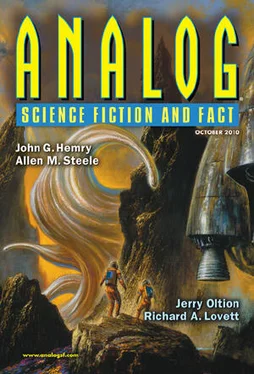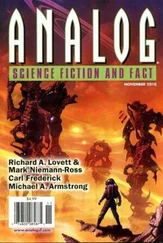Allen Steele - The Great Galactic Ghoul
Здесь есть возможность читать онлайн «Allen Steele - The Great Galactic Ghoul» весь текст электронной книги совершенно бесплатно (целиком полную версию без сокращений). В некоторых случаях можно слушать аудио, скачать через торрент в формате fb2 и присутствует краткое содержание. Год выпуска: 2010, Издательство: Dell Magazines, Жанр: Фантастика и фэнтези, на английском языке. Описание произведения, (предисловие) а так же отзывы посетителей доступны на портале библиотеки ЛибКат.
- Название:The Great Galactic Ghoul
- Автор:
- Издательство:Dell Magazines
- Жанр:
- Год:2010
- ISBN:нет данных
- Рейтинг книги:4 / 5. Голосов: 1
-
Избранное:Добавить в избранное
- Отзывы:
-
Ваша оценка:
- 80
- 1
- 2
- 3
- 4
- 5
The Great Galactic Ghoul: краткое содержание, описание и аннотация
Предлагаем к чтению аннотацию, описание, краткое содержание или предисловие (зависит от того, что написал сам автор книги «The Great Galactic Ghoul»). Если вы не нашли необходимую информацию о книге — напишите в комментариях, мы постараемся отыскать её.
The Great Galactic Ghoul — читать онлайн бесплатно полную книгу (весь текст) целиком
Ниже представлен текст книги, разбитый по страницам. Система сохранения места последней прочитанной страницы, позволяет с удобством читать онлайн бесплатно книгу «The Great Galactic Ghoul», без необходимости каждый раз заново искать на чём Вы остановились. Поставьте закладку, и сможете в любой момент перейти на страницу, на которой закончили чтение.
Интервал:
Закладка:
The Great Galactic Ghoul
by Allen M. Steele
In the late twentieth century, the first unmanned probes were sent to Mars. Most of them failed; of the thirty-nine missions launched by America and Russia between 1960 and 1999, nine exploded during lift-off, seven lost contact with home, seven more either went into useless orbits or missed the planet entirely, and four crashed while attempting to land. No other program had the same failure rate, nor as many mishaps that couldn’t be easily explained.
This led someone at NASA to playfully suggest that a creature lurked between Earth and Mars, a gremlin ready to sabotage or destroy any spacecraft that dared to enter its realm. The Great Galactic Ghoul became a standing joke among engineers and ground controllers, but as the missions continued to fail, the laughter stopped. It soon became considered bad luck to mention the Ghoul. Even if these otherwise rational men didn’t necessarily believe in space monsters, neither were they willing to say anything that might jinx the mission.
Despite the setbacks, Mars was explored and people eventually went there, and not long after that they began to travel farther out into the solar system. By then, they’d learned how to build spacecraft that were reasonably safe and reliable; they had to, because the consequences of catastrophic failure were unthinkably high. There were accidents, of course, and occasionally a life was lost, but those instances were rare; when they occurred, more often than not human error was the primary cause. In any case, investigations would be announced, studies would be conducted, data collected, reports written, findings made public. Changes would then be instituted, and if the process worked the way it was supposed to, that particular accident would never happen again. Or at least not quite the same way.
In time, the Great Galactic Ghoul was forgotten. But he didn’t disappear. He simply went into hiding for a while, waiting for the day to come when he could return from the shadows and wreak havoc upon any vessel he happened to encounter in the darkness between worlds.
Until August 16, 2062, there had never been a deep-space rescue mission. There were countless instances, of course, between Earth and the Moon in which one spacecraft made an emergency rendezvous with another. The distance involved there was less than a quarter of a million miles, though, and since there were over a dozen stations in cislunar space, help was seldom more than a few hours away. Beyond the Moon, the situation was different: spacecraft crews were expected to deal with onboard accidents themselves, without relying on outside assistance. And for good reason: Earth and Mars were separated by an average of forty-nine million miles, and even in the most densely populated zone of the asteroid belt, tens of thousands of miles could lay between one inhabited rock and another.
Nonetheless, it wasn’t long before spacers realized that they needed to plan for coming to one another’s aid. No one could anticipate every sort of emergency, but there were times when it would have been helpful to know, no matter how bad things might be, that help was on the way. Indeed, one of the first things the Pax Astra did after it was formed in 2049 was to ratify the space rescue clause of the old 1967 U.N. Space Treaty, even though the Pax rejected most of the treaty’s other provisions. As much as the newly independent space colonies wanted to break away from Earth, this part of the treaty, which mandated that all space vessels had to respond to distress signals, was worth keeping.
It’s a good thing that the Pax settled this particular issue, for only six years later the belt colonies broke away to form their own alliance, the Transient Body Shipping Association. Since the TBSA was willing to do business directly with Earth-based companies and governments, economic rivalry with the Pax Astra was assured. So it was just as well that Pax and TBSA ships formally agreed to come to each other’s aid in times of emergency; by 2065, each side would be committing piracy against the other, with worse yet to come.
But hostilities hadn’t yet broken out when the Ritchie Explorer disaster occurred. Considering that the Ritchie was a Pax Astra vessel, perhaps it was only appropriate that the nearest ship to receive its mayday signal was a TBSA freighter.
The TBSA Gold Dust Woman was seven weeks out of Ceres, passing Mars orbit on its way to the Moon, when the signal was received by its Ku-band wireless. Because the ship was no longer in the belt, Captain Henry Zimmerman had relaxed the twenty-four-hour watch mandated by flight regulations. Chief Engineer Quon Ko remembers being in his berth, nursing a squeezebulb of Irish coffee while reading a fantasy potboiler on the data screen, when Zimmerman’s voice came over the intercom, asking him to report to the bridge.
“I didn’t ask what it was about,” Quon says. “I just said okay, be there in a minute, then I climbed out of my bunk, zipped up my jumpsuit and tossed the rest of my drink into the recycler, then headed upstairs.”
Gold Dust Woman was an Ares-class freighter, 272 feet in length and 110 abeam at its outrigger telemetry and reactor booms, the sort of workhorse known by spacers as a “rock hauler” even though it never carried asteroids themselves. It had a nuclear fusion main engine and an open payload bay capable of carrying up to eight cargo containers—on this mission it had six, mainly oxygen, water, copper, and titanium mined from inner-belt asteroids—and it had a crew of three: Captain Zimmerman; Lesley Zimmerman, his first officer, navigator, and wife; and Quon Ko, who doubled as engineering chief and cargomaster. The Zimmermans were the Woman ’s permanent crew, while Quon was aboard only until the union rotated him out and gave his job to someone else.
As it turned out, Henry and Lesley weren’t on the bridge either when the signal was received. Captain Zimmerman was in the observation blister, using the optical telescope to make a manual navigational fix as required by regulations, while Lesley was napping in their cabin. So the transmission was first heard by the ship’s AI, which in turn alerted the captain. It took Henry Zimmerman less than a minute to ride his chair down from the blister to the bridge, and only a minute after that to confirm that the signal was an emergency transmission sent by another spacecraft. A stickler for following TBSA regs to the letter, the captain immediately summoned the other senior officers to the bridge; as it so happened, his wife and Ko were also the only other two people aboard.
By the time Lesley and Ko left the living quarters in the ship’s carousel and climbed up the access shaft to the bridge, Henry had learned other pertinent facts. The signal was coming from the PASS Ritchie Explorer , a mobile mining rig registered to the Pax Astra. The Explorer was presently anchored to Eros, an S-type asteroid whose annual period presently put it just within Mars orbit. According to the TBSA database, it had a crew of six.
Beyond that, little else was known. The signal, apparently sent by an automatic transponder, consisted of a brief print message that repeated again and again:
MESS. 1397 1503 GMT 8/16/62 CODE A1/0679
TRANSMISSION FROM PASS RITCHIE EXPLORER/433 EROS TO ALL SPACECRAFT PRIORITY REPEATER
MESSAGE BEGINS
MAYDAY MAYDAY MAYDAY
PASS RITCHIE EXPLORER EXPERIENCING LIFE-THREATENING EMERGENCY BREAK EXPLOSION OF UNKNOWN ORIGIN BREAK POSSIBLE CASUALTIES AND/OR FATALITIES BREAK REQUEST URGENT ASSISTANCE FROM NEAREST AVAILABLE VESSEL BREAK LOCATION ASTEROID 433 EROS CRATER HIMEROS 070S 2800W BREAK PLEASE RESPOND ASAP
MESSAGE ENDS
TRANSMISSION REPEATS
Читать дальшеИнтервал:
Закладка:
Похожие книги на «The Great Galactic Ghoul»
Представляем Вашему вниманию похожие книги на «The Great Galactic Ghoul» списком для выбора. Мы отобрали схожую по названию и смыслу литературу в надежде предоставить читателям больше вариантов отыскать новые, интересные, ещё непрочитанные произведения.
Обсуждение, отзывы о книге «The Great Galactic Ghoul» и просто собственные мнения читателей. Оставьте ваши комментарии, напишите, что Вы думаете о произведении, его смысле или главных героях. Укажите что конкретно понравилось, а что нет, и почему Вы так считаете.












